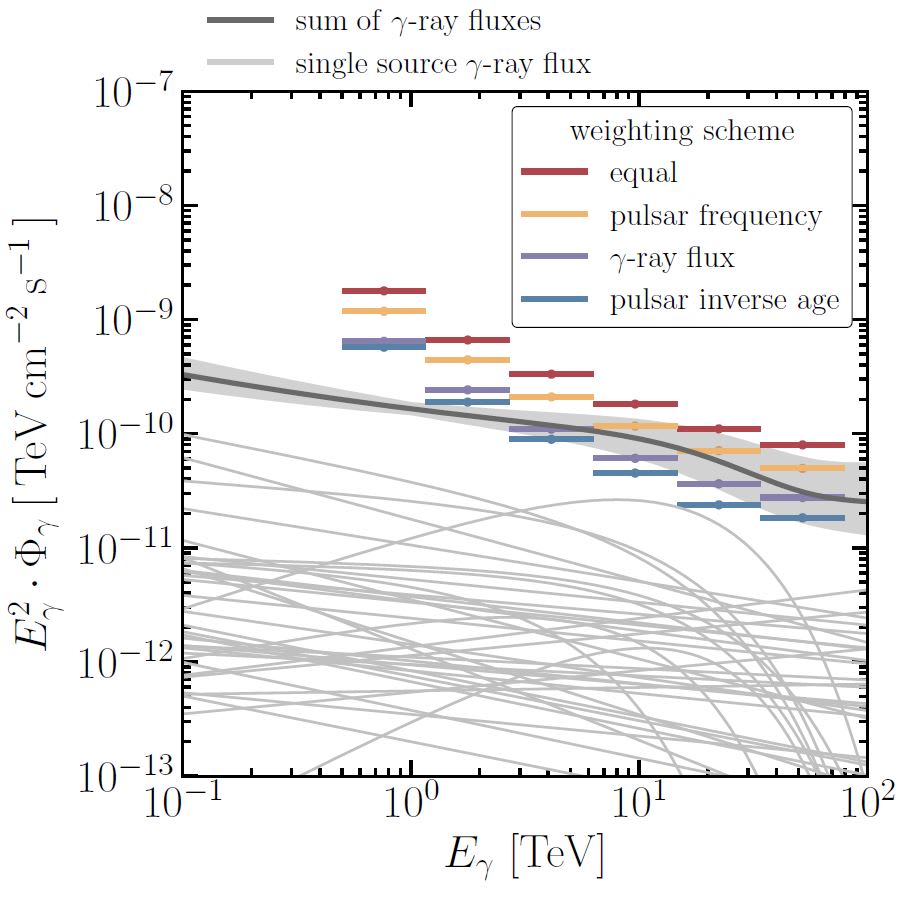A giant star will go out with a bang: When it dies, it explodes in a supernova, leaving behind a diffuse cloud of gas and dust around its own small, compact core, often in the form of a neutron star. A pulsar is a rapidly rotating neutron star with an extremely strong magnetic field that beams electromagnetic radiation as it spins, like an interstellar lighthouse. Some pulsars also generate a strong wind of charged particles, resulting in a type of nebula called a “pulsar wind nebula.”
Pulsar wind nebulae might explain how and where charged particles called cosmic rays get accelerated to their high energies. And neutrinos, the nearly massless subatomic particles studied by the IceCube Neutrino Observatory at the South Pole, can help researchers get closer to figuring that out.
In a paper recently submitted to The Astrophysical Journal, the IceCube Collaboration outlines an analysis that searched for neutrino emission from 35 pulsar wind nebulae in 9.5 years of IceCube data. They did not find any significant correlation, so the researchers set upper limits on total neutrino emission from these objects.

Astronomers know that pulsar wind nebulae emit gamma rays at energies on the scale of a trillion electronvolts (known as a teraelectronvolt, TeV); in fact, according to observations, they are the most abundant TeV gamma-ray emitters in the Milky Way, and some models predict that they are also sources of cosmic rays and neutrinos.
Cosmic rays are highly energetic subatomic particles that we detect coming from outer space. When they interact with surrounding molecules or radiation, they produce gamma rays and neutrinos. But since gamma rays can also be produced without cosmic ray interaction, just detecting them doesn’t tell us much. Seeing gamma rays and neutrinos from a particular source, however, would be a smoking gun for a cosmic-ray accelerator.
So, in search of neutrino correlation, IceCube collaborators performed an analysis of 35 pulsar wind nebulae with observed TeV gamma-ray emission. They then evaluated the significance of the possible correlation using four different hypotheses: First they assumed that the possible neutrino emission is proportional to the high-energy gamma-ray flux associated with the sources. They also assumed that all sources have equal probability of emitting neutrinos as well as the hypothesis that sources with faster spinning central pulsars are preferred. Finally, they examined whether younger sources are preferred because they can be more energetic.
Ultimately, the researchers did not find significant correlation of IceCube neutrinos and the 35 pulsar wind nebulae. Therefore, they set upper limits on the maximum neutrino flux that can be expected from these sources. They also limited the fraction of hadronic gamma rays in the total gamma-ray flux observed from the sources, providing constraints for the modeling of pulsar wind nebulae.
“The presence of hadrons in pulsar wind nebulae has significant impact on our understanding of the particle acceleration in these major gamma-ray emitters in the Milky Way,” says Ali Kheirandish, a postdoc at Pennsylvania State University and one of the leads on this analysis. “Even a small contribution of ions can help resolve tensions in the modeling of the high-energy emission from pulsar winds, and the obtained upper limits on the hadronic contributions in this analysis aim at overcoming this obstacle.”
According to Qinrui Liu, a graduate student at the University of Wisconsin–Madison and another lead on this analysis, “These results bring us closer to eventually understanding whether pulsar wind nebulae are sites of very high energy cosmic-ray acceleration.”
info “IceCube Search for High-Energy Neutrino Emission from TeV Pulsar Wind Nebulae,” IceCube Collaboration: M. G. Aartsen et al., The Astrophysical Journal 898 (2020) 2, 117, iopscience.iop.org, arxiv.org/abs/2003.12071